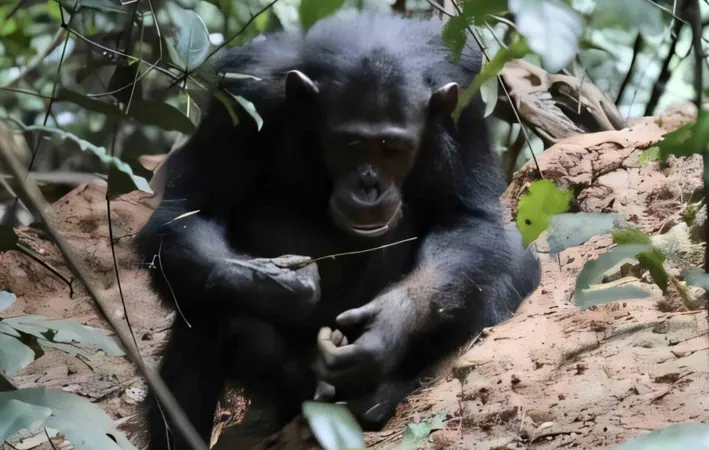
Chimpanzee "Engineering" Breakthrough: Is This the Key to Understanding Ancient Human Tool Use?
2025-03-26
Author: Daniel
Introduction
Recent groundbreaking research from Oxford University has uncovered surprising engineering-like behaviors in chimpanzees that could unlock secrets about the evolution of tool use in our human ancestors. The findings, led by Dr. Alejandra Pascual-Garrido and her multidisciplinary team, focus on chimpanzees in Tanzania who exhibit a sophisticated selection process when it comes to the plants they use for retrieving termites, a crucial food source.
Study Overview
This study, conducted in the lush Gombe Stream National Park, highlights the remarkable cognitive abilities of chimpanzees as they choose specific plant materials that function optimally for "termite fishing." During their investigations, the researchers observed that chimpanzees selectively pick long, slender plant parts, showcasing their understanding of mechanical properties necessary for extracting insects from complex nests.
Chimpanzee Tool Selection
The research revealed that chimpanzees favor materials that are more flexible and better suited for the task at hand. Alarmingly, some plants that were never seen utilized in this way proved to be up to 175% more rigid than those employed by the chimpanzees. This indicates that they are not just randomly grabbing any material; they are deliberately selecting tools that will aid their survival.
Significance of the Findings
Dr. Pascual-Garrido states, "This study presents the first comprehensive evidence that wild chimpanzees actively choose tool-making materials based on specific mechanical traits." These insights extend previous observations regarding chimpanzee behavior and their use of tools, offering a glimpse into a culture of tool-making that spans regions and generations.
Implications for Human Evolution
Interestingly, plants such as Grewia, which are among the most favored by chimpanzees for tool use, have been found in locations as far as 5,000 kilometers away from Tanzania. This raises fascinating questions about potential communication or learned behavior among distant chimpanzee populations. Are these animals capable of sharing knowledge about effective foraging techniques across vast territories?
Broader Impact on Understanding Tool Use
The implications of this research extend far beyond our understanding of chimpanzees. As Adam van Casteren of the Max Planck Institute emphasizes, the mechanical principles guiding tool construction are timeless and may provide insights into how early human ancestors evolved their own engineering skills. Since the tools made by early humans, primarily from perishable materials like wood, seldom survive in archaeological records, these studies offer a rare chance to connect behavioral dots from modern primates to our ancient relatives.
Cultural and Educational Insights
In the ever-evolving narrative of human evolution, understanding how knowledge is passed down within chimpanzee communities also sheds light on human learning and cultural development. Are young chimpanzees learning from their parents and elders, just as humans do? This connection could inform our understanding of social structures and educational habits of early humanoids.
Conclusion
Ongoing examination of chimpanzee material selection is set to unlock more mysteries surrounding human ancestry, particularly as researchers work to piece together the connections between ancient tool use and present-day primate behavior. This study not only enriches our knowledge but also presents an invaluable window into the innovative steps taken by our early ancestors towards modern technological advances.
Publication Details
Published in iScience, the study titled "Engineering skills in the manufacture of tools by wild chimpanzees" by Alejandra Pascual-Garrido et al. marks a significant milestone in anthropology, offering new perspectives on the intersection of animal behavior and human evolution. As we continue to explore these parallels, the age-old question of what separates us from our primate cousins takes on fresh dimensions. Stay tuned for more exciting developments in this fascinating field!

 Brasil (PT)
Brasil (PT)
 Canada (EN)
Canada (EN)
 Chile (ES)
Chile (ES)
 Česko (CS)
Česko (CS)
 대한민국 (KO)
대한민국 (KO)
 España (ES)
España (ES)
 France (FR)
France (FR)
 Hong Kong (EN)
Hong Kong (EN)
 Italia (IT)
Italia (IT)
 日本 (JA)
日本 (JA)
 Magyarország (HU)
Magyarország (HU)
 Norge (NO)
Norge (NO)
 Polska (PL)
Polska (PL)
 Schweiz (DE)
Schweiz (DE)
 Singapore (EN)
Singapore (EN)
 Sverige (SV)
Sverige (SV)
 Suomi (FI)
Suomi (FI)
 Türkiye (TR)
Türkiye (TR)
 الإمارات العربية المتحدة (AR)
الإمارات العربية المتحدة (AR)